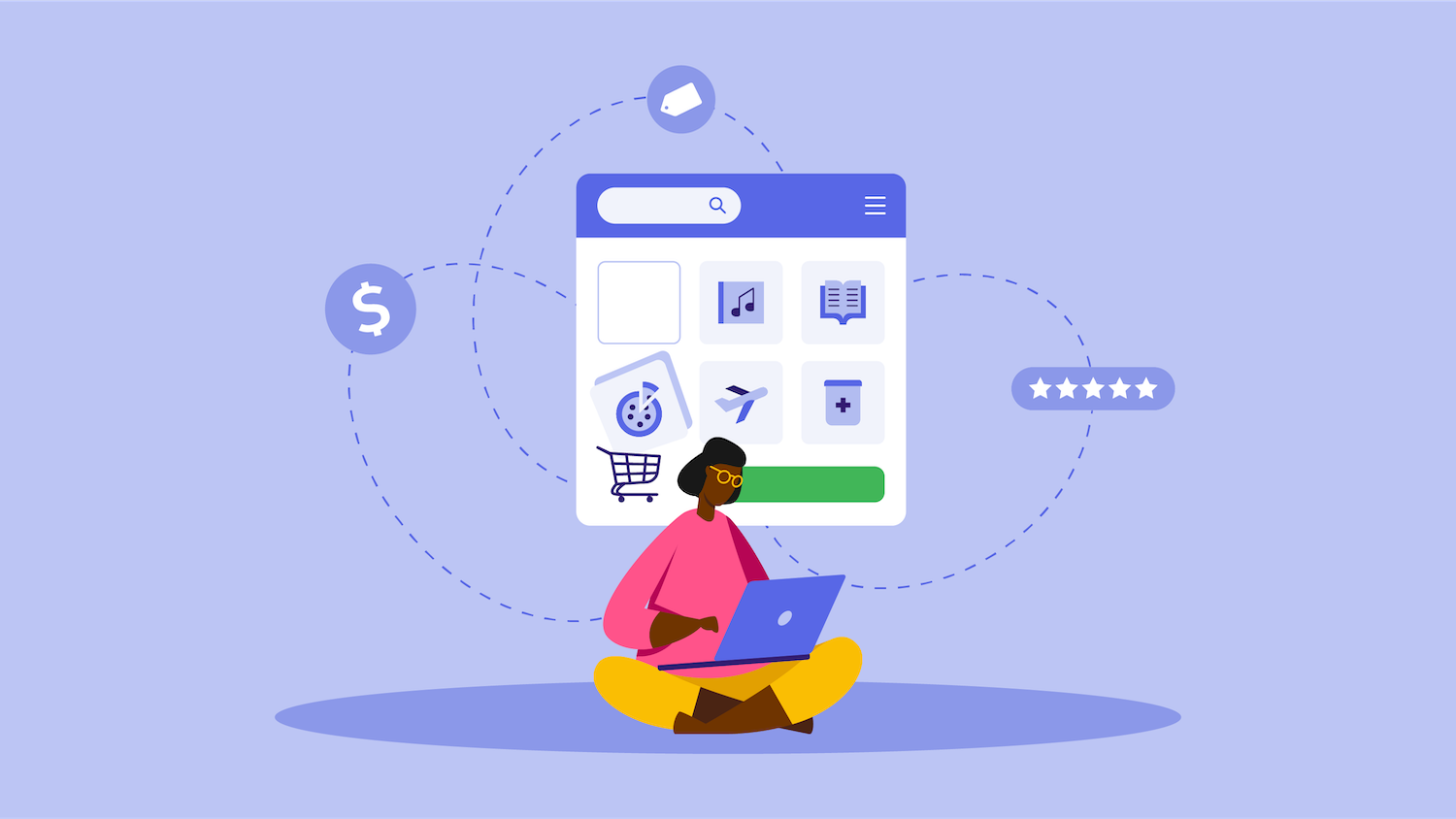Online stores used to only provide concise product descriptions and SEO text, forcing people to look elsewhere for additional Content commerce. Content and commerce are increasingly being combined in ecommerce today. Online customers want to be entertained, informed and inspired throughout the whole buying process. Content-driven commerce or content commerce offers many opportunities to companies. Companies can retain customers by providing a great digital experience. However, the implementation of this is difficult.
What are the benefits of content marketing for e-commerce? What technologies are required and how does it work? This article provides a detailed explanation of content commerce.
Content commerce definition
Content commerce can be defined as when a business publishes and distributes digital content in order to increase product sales via digital channels, such as an online store. But simply providing content is not enough. To provide the best shopping experience, content-driven commerce must be integrated strategically into the purchasing process.
Content should support the entire digital customer journey, from the initial concept, through the selection of products and purchases, to the usage of the product following purchase. The content that customers need must be available at all times and on any digital touchpoint.
Why does content commerce become more important?
As more and more buyer journeys move to digital channels, this trend is increasing. Closures of local retail stores during the COVID-19 epidemic have accelerated this tendency.
Manufacturers and retailers should offer customers a similar experience online as they do in brick-and mortar stores, without individual sales staff or the ability to touch and try products. For this, online stores should be expanded to become more than just product catalogs that have a checkout feature. Content — images, videos, and interactive elements — is the only way to “recreate” high quality customer experiences in order to share the story of a brand in a positive, authentic manner.
Customers have many questions and want to be sure they’re making the best decision. Advice on travel, fashion, and technical products should be given priority. Answers can be found in content creation. Customers are also increasingly looking for entertainment and inspiration when shopping, beyond just information. It is nearly impossible to compete with ecommerce giants such as Amazon or global brands when it comes to performance and offering. Many products are interchangeable. Unique content allows you to stand out and bind your customers to your brand.
Related: 9 Types of Marketing strategy to Promote your Business Brand
What are the opportunities for content commerce?
Content-led commerce has many benefits for your business or organization. Content commerce has many benefits.
Experience a high-quality customer experience
Online shopping is not a good substitute for shopping in person. It’s too technical and boring. And it doesn’t offer the same experience. For those who wanted advice, they preferred to visit a real store.
Content-driven commerce allows retailers and brands to offer better shopping experiences, including advice and excitement.
Higher Purchase Rate
According to different studies, 60-80% of online shoppers abandon products in their shopping carts and never complete the purchase. This is because doubts can occur shortly before the payment. Customers may ask, “Is this product right for me?”.
Lower Rate of Return
A Sales Cycle report shows that one out of four online purchases is returned. In certain product categories such as fashion two thirds of all orders end up being returned. The most common reasons are:
The most common reasons for this are:
- It looks different from the photos.
- The garment is larger or smaller than normal
- When customers try out the product, they realize that it doesn’t live up to their expectations
- You can reduce the number and size of returns by providing your customers with detailed information and photos.
Customer service: Relieving the burden
Less returns mean less work for call centers, customer service and return processing. Use content such as FAQs or how-to guides to help your customers make the most of the product and avoid making mistakes. They will have fewer issues to deal with through customer service.
Difference from competitors
You competitors may offer similar products or sell the same line. It is difficult to differentiate yourself solely based on the products you sell. It’s impossible to offer more customer service than Amazon.
Content is one of the rare opportunities to stand out in the ecommerce world. Your content can give customers an experience they will only find with you.
More suggestions
Even in this digital age, “asking around” and word-of-mouth are still important for making purchasing decisions. Sending a link to an online store without any additional content is not fun. You can encourage your target audience to share you on social media and messaging apps by creating unique, entertaining content.
Search Engine Optimizing (SEO).
Google, YouTube and Pinterest are all great tools for finding products or ideas. They can also be the first step in a purchasing process. In general, organic traffic makes up between one third and one half of all online store visits. You will be more visible through your content — not just with your online shop, but also with the other channels you use.
Personalization is a key success factor
As ecommerce websites or companies create more content, the likelihood of customers becoming overwhelmed and confused will increase. Content-driven commerce relies on presenting customers with only the content they require at any given time.
Personalization began with the individualized email. Content management and ecommerce systems allow customers to see individual campaigns, products, or informative content. The store or website may look completely different for different groups of clients or individuals. Many examples of content personalization are available to illustrate this approach.
Companies can personalize content by creating different groups of customers and assigning them manually, such as private or business customers, or male or female clients. Algorithms are increasingly taking on this task, assigning visitors or customers to segments based upon certain characteristics and playing personalized content. This works better the more information companies have on their customers.
Implementation of content commerce
The technical implementation of content commerce is challenging, despite its advantages in marketing and sales. In the past, there was a “division” of labor: the online store managed the products and the content-management system handled the website, landing pages, blogs and other content. Connected are other systems.
Content-driven commerce is impossible with disparate or only partially compatible systems. It is nearly impossible to implement this with systems that are not compatible or are only partially compatible.
What is the problem and how can it be solved?
Technical Challenges
Data and content are spread across different systems. Each system has strengths and functions that make it more or less suited to certain types of content. Images and videos are managed by digital asset management software and images and product data in store solutions. Data for personalization is derived from analytics software.
This data must be “assembled”, in order to create a digital experience that is uniform. It is a complex process, if this works at all. Data must be maintained in multiple locations, often twice or three times for different formats and channels.
The user experience is different across channels, such as desktops and apps. Personalization and tracking do not work on all channels.
Implementation using a CMS without a user interface
A headless CMS is the perfect building block for implementing a content commerce concept. Connect all data sources into the CMS.
Content authors are able to work with data and content just as if they were native content already in the CMS. The content is used to create campaigns and content experiences. They can also create variations for personalization.
Content can be delivered to an almost infinite number of front ends and channels. All content is controlled centrally, allowing for a consistent experience across all channels. This makes omnichannel marketing possible.
What is content commerce?
Content commerce provides a rich and engaging experience to visitors through the integration of high-quality images, descriptive content and customer reviews. It also includes personalized recommendations and social media elements.
It is important to offer valuable information to customers, to build trust and to encourage them to make purchases, while providing a seamless experience.
Do you need to be more specific?
We’ll show you how to seamlessly integrate high-quality content into the entire online shopping experience, ensuring that customers have a unique and fun shopping experience.
Imagine a hypothetical “DressOk!” website. These are some content strategies.
Home Page
Homepages should include attractive visuals and engaging content. They also need to feature featured products. The homepage may include a carousel, or hero banner that displays high-quality images of the products or promotion along with compelling headlines and buttons to take action.
Product pages
Each product page should include detailed product information, high resolution images, and reviews from customers. The product page should include information about the features, benefits and specifications of the product. This will provide visitors with an informative and rich experience.
Blog section
DressOK! A dedicated blog should be created that provides valuable articles, tutorials and industry insights about the products sold. Blog posts should include eye-catching images, headlines that engage, and educational content written well to entertain readers. Blog posts can include links to relevant products that will guide readers towards purchasing.
Social Media
It should include social media marketing by displaying social media feeds and accounts of the brand. The website can display visually appealing videos and images shared on platforms such as Instagram, Facebook or YouTube. These posts can highlight customer testimonials or behind the scenes content. They create a connection between a brand and its clients.
User generated content
DressOk! DressOk! should encourage customers to share experiences via user-generated content. A section of the website could be dedicated to showing customer-submitted videos or images featuring products that they have purchased. User content can create a sense community and authenticity as customers are able to see actual people using the products.
Personalization
Websites can personalize their user experience by using data from customers and their browsing habits. It should display recommended products based upon the customer’s previous purchases, stories, items viewed, or preferences. These recommendations include visually appealing images, personalized product descriptions and a personal touch. This increases the chances of conversion.
What are the ways you can enrich commerce data by adding content to a CMS such as Magnolia?
Magnolia’s headless CMS allows you to combine data and content from multiple sources. Store solutions manage data products and marketing text controlled by the content management system. Digital asset management software handles images and videos. Customer data platform provides data necessary for personalization.
Read more:









